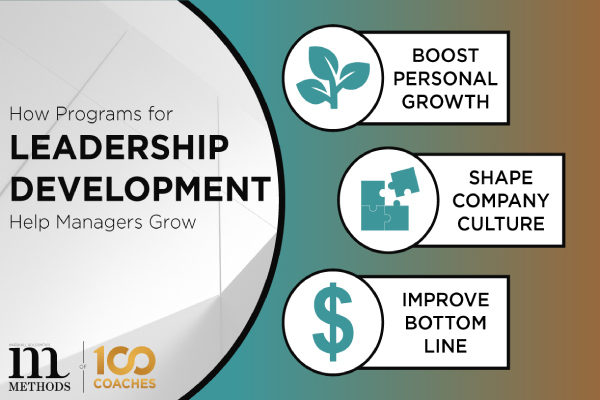How do businesses improve? The first step often involves training. As the great Marshall Goldsmith says, “what got you here won’t get you there.” While this may seem nebulous or “fluffy,” it’s underlined by a very crucial point in leadership training: just because a person excels in their job and gets promoted to a management or leadership position doesn’t necessarily mean that they’ll be skilled in leadership and management as well. When you consider where most leaders got their start in their careers, they were regular knowledge workers in their given field, eventually working their way up in skills and confidence until they were likely recognized by a manager or their boss and selected for promotion. The thinking there being “since they’re so good at their jobs now, if they were a manager or a boss, they’ll be able to teach others in their former position how to achieve as much as they did.” Perfectly logical, right? Right, except for one key factor: being a subject matter in whatever field usually doesn’t mean that you’re going to be well-versed in management as well. Regardless of the industry in which you work, management and leadership skills are entirely separate from the daily operations of a business. They involve more ‘soft-skills’ like interpersonal relationship management. And the fact is, these skills, if you haven’t been taught them by a professional leadership coach or training course, can be hard to come by. Because of this fact, there are a number of ways in which you can improve your leadership.
But before we look at the different types of training available, let’s examine just why leadership training is so important for any business looking to expand, or even just continue on at their current pace in a sustainable way, making sure their teams are happy and doing their best work.

Leadership training is important because it helps you:
- Get the most out of your leaders and develop them into the best people they can be.
When your leadership team and management are performing at their highest levels, they are creating healthy, positive work cultures in which employees can thrive and do their best work. Good leaders also help to develop individual employees who may provide assistance or training — all of which a good leader or manager can provide.
- Increase team performance and your bottom line.
When you tap into each employees’ strengths and develop them into the best team mates they can be, they perform better, and are generally happier while doing it; all of this helps bolster your company’s bottom line and ultimately will increase your profits.
- Stay up to date with the fast paced culture of business and modern trends to retain new talent.
One of the most valuable groups of people for any business to tap into in the newest generation of workers — because they’ll end up being the future of your business. Staying up to date on workplace trends can help you create attractive environments for young people to want to join your company and help move it forward.
So, without a doubt, investing in some form of leadership training is well worth the time and effort as it can exponentially increase your business and teams’ capacity to excel. However, the task of deciding how to train your leaders and employees can be a daunting one; there are so many options and platforms and coaches out there, that deciding between any of this can feel overwhelming. Let’s examine a few common types of leadership training and what each offer:
Typically, leadership training is deployed in these three arenas:

1. Live workshops and seminars, conferences.
Perhaps one of the most common ways companies engage in leadership training is through large-scale workshops, seminars, or conferences. These are typically in-person events where a hired speaker — an expert in whatever topic, usually management or leadership related — gets on stage in front of a group of people and delivers a set presentation on whichever topic is chosen for that particular event. They can be great for opening peoples’ minds and teaching them new concepts, and it’s a great way to deliver a certain level of training to a large number of people all at once. Unfortunately, with the onset of the pandemic, we saw a huge dip in attendance to events like these are many of them were canceled or postponed, and in a post-vaccine world, many are still hesitant about going out. The other downside to events like these are that they’re often not tailored specifically to a company, and offer a more or less “one-size-fits-all” approach to leadership and management training.

2. Personalized coaches hired to come to your company.
This is similar to the workshop or seminar format, though personalized more to your company or team. Typically, in situations like these, a company will hire a specific coach whose expertise they feel matches the needs of their business to come and speak to their teams — or even just particular executives — to help them overcome whatever leadership or management challenges they’re currently facing. This option works great for companies with larger budgets, as speakers who come on a small group or individual basis will typically charge a lot more for their time than, let’s say, the price of one ticket to an event for which they’re presenting, where the number of attendees drives the individual price down. Another downside to this approach is that the training typically only happens once, and you run the risk of the training not “sticking” the first time.

3. Online leadership programs.
One of the most efficient ways to train, especially in the COVID age, is through online training programs. These primarily take the form of video, rather than written materials, and are pre-filmed and delivered through a training provider. Here at Methods, we offer a robust library of leadership training courses, taught by the highest grade of executive coaches in the world, and our proprietary Lightspeed VT training system offers the closest alternative to in-person training with our customer subjective user response technology. Online training programs are often the best value as they don’t require traveling to a seminar or workshop, nor does it require the upfront cost of hiring a coach to come to your business specifically, and with our content, you can watch it again and again to ensure retention and encourage longevity in the knowledge.

If you care about the future of your business, and want to get the most out of your managers and people generally, leadership training is a “must have” and not just a “nice to have.” We all understand the importance of training for job skills — those individual tasks pertaining to the operations of our businesses — but seldom do we place the same degree of importance on leadership training. The time for that to change is now, and with the abundance of available options for training, you’ve got no excuse not to.
For more actionable tips like these, and get exclusive discount right now when you sign up to receive our monthly newsletter!





